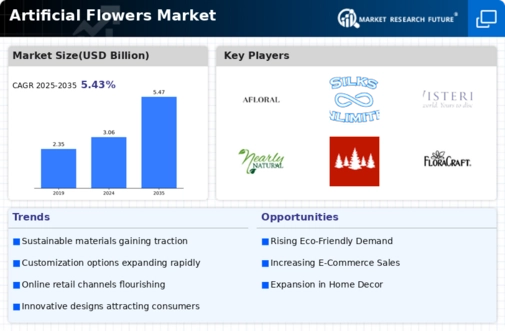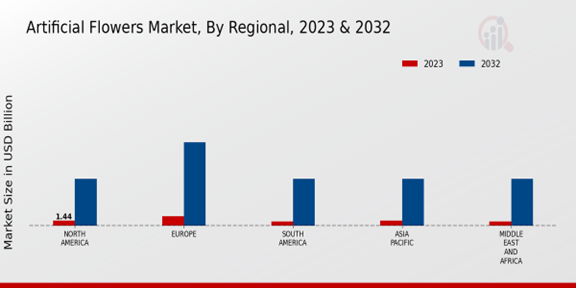Sustainability Trends
The increasing emphasis on sustainability plays a crucial role in shaping the Global Artificial Flowers Market Industry. Consumers are becoming more environmentally conscious, leading to a preference for products that minimize waste and resource consumption. Artificial flowers, which do not require water or sunlight, align with these sustainability goals. This shift is particularly relevant as the market anticipates reaching 5.47 USD Billion by 2035, suggesting a long-term commitment to eco-friendly decor options. Retailers are responding by offering a wider range of sustainable artificial flower products, further driving market growth.
Market Growth Projections
Rising Demand for Home Decor
The Global Artificial Flowers Market Industry experiences a notable surge in demand driven by the increasing popularity of home decor. As consumers seek to enhance their living spaces, artificial flowers provide a low-maintenance alternative to fresh blooms. This trend is particularly evident in urban areas where space constraints limit gardening options. The market is projected to reach 3.06 USD Billion in 2024, reflecting a growing preference for aesthetically pleasing yet practical decor solutions. Furthermore, the versatility of artificial flowers allows for seasonal and thematic decorations, appealing to a broad consumer base and contributing to the industry's expansion.
Growth in E-commerce Platforms
The rise of e-commerce platforms significantly impacts the Global Artificial Flowers Market Industry by providing consumers with convenient access to a diverse range of products. Online shopping enables customers to explore various styles, colors, and arrangements from the comfort of their homes. This accessibility is particularly appealing to younger demographics who prefer digital shopping experiences. As e-commerce continues to expand, it is likely to contribute to the market's growth trajectory, facilitating increased sales and brand visibility for artificial flower manufacturers.
Cultural and Seasonal Celebrations
Cultural and seasonal celebrations serve as a vital driver for the Global Artificial Flowers Market Industry. Events such as weddings, holidays, and festivals often necessitate decorative elements, and artificial flowers offer a practical solution for creating visually appealing arrangements. The ability to reuse and repurpose artificial flowers for multiple occasions enhances their attractiveness to consumers. This trend indicates a steady demand for artificial flowers throughout the year, supporting the industry's growth as consumers seek versatile decor options for various celebrations.
Advancements in Manufacturing Techniques
Technological innovations in the production of artificial flowers significantly influence the Global Artificial Flowers Market Industry. Enhanced manufacturing techniques, such as the use of high-quality materials and realistic designs, improve the overall appeal of artificial flowers. These advancements not only elevate the aesthetic value but also ensure durability and longevity, making them a preferred choice among consumers. As a result, the market is expected to grow at a CAGR of 5.43% from 2025 to 2035, indicating a robust trajectory fueled by continuous improvements in product quality and design.


















